 W
WThis is a list of castles in the Eastern Mediterranean and Middle East, founded or occupied during the Crusades. For crusader castles in Poland and the Baltic states, see Ordensburg.
 W
WThe castle of Amouda Crusader castle, formerly in the Armenian Kingdom of Cilicia, and today in the Turkish Province of Osmaniye. The castle was deeded by the Armenian king Levon I to the Teutonic Knights in 1212 and rebuilt by them in the 13th century. It earned revenue for the Teutonic Order from the surrounding land. According to contemporary sources, the castle provided shelter for 2,200 people during the invasion by the Mamluks in 1266.
 W
WApollonia, known in the Early Islamic period as Arsuf and in the Crusader Kingdom of Jerusalem as Arsur, was an ancient city on the Mediterranean coast of what is today Israel. In Israeli archaeology it is known as Tel Arshaf. Founded by the Phoenicians during the Persian period in the late sixth century BCE, it was inhabited continuously until the Crusader period, through the Hellenistic, Roman, and Byzantine periods, during the latter being renamed to Sozusa. It was situated on a sandy area ending towards the sea with a cliff, about 34 kilometres (21 mi) south of Caesarea.
 W
WAtlit naval base is a classified Israeli Navy base on the northern Mediterranean coast of Israel. The base is home to Shayetet 13, Israel's naval commando unit. Within its grounds stands Château Pèlerin, a medieval crusader fortress currently closed to the public.
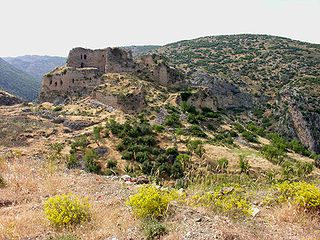 W
WBagras or Baghrās but realistically Bagdas/Bagdans or Bogd·apo, ancient Pagrae, is a town and its nearby castle in the İskenderun district of Turkey, in the Amanus Mountains.
 W
WBeirut Castle was a major Crusader castle located in downtown Beirut, Lebanon. It was mostly built during the Crusades and demolished during works of extension of the Port of Beirut in the late 19th century.
 W
WBuffavento Castle is a castle in Northern Cyprus. The exact date of its construction remains unknown, the most plausible theory being the Byzantine period. It combines Byzantine and Frankish architectural elements. It fell into disuse in the 14th century.
 W
WByblos is a city in the Keserwan-Jbeil Governorate of Lebanon. It is believed to have been first occupied between 8800 and 7000 BC and continuously inhabited since 5000 BC, making it one of the oldest continuously inhabited cities in the world. It is a UNESCO World Heritage Site.
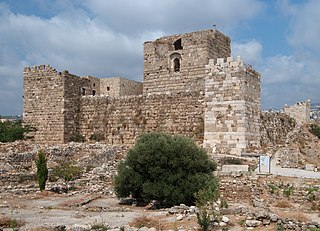 W
WByblos Castle is a Crusader castle in Byblos, Lebanon. In Crusader times it was known as the Castle of Gibelet, also spelled Giblet. It is adjacent to the Phoenician archaeological site containing the ruins of the Temple of Baalat Gebal and the Temple of the Obelisks.
 W
WCaesarea Maritima, formerly Strato's Tower, also known as Caesarea Palestinae, was an ancient city in the Sharon Plain on the coast of the Mediterranean, now in ruins and included in an Israeli national park.
 W
WCafarlet or Capharleth or Kafr Lam is an Early Muslim coastal fortress of the Roman castrum type. Today it is located inside Moshav HaBonim, Israel, on lands of the now abandoned Arab village of Kafr Lam. It was built in the 8th or 9th century, during the Umayyad or Abbasid period to serve as a ribat against Byzantine attacks, and was significantly modified and reused by the Crusaders. It is one of the few surviving ancient fortifications in Israel featuring round watchtowers, indicting the fortress' origins predate the crusader era. Most surviving ancient fortifications in the region feature rectangular watchtowers, typical of the style prevalent in Europe during the time of the crusaders.
 W
WAchziv is an ancient site on the Mediterranean coast of northern Israel, between the border with Lebanon and the city of Acre. It is located 13.5 kilometres (8.4 mi) north of Acre on the coast of the Mediterranean Sea, within the municipal area of Nahariya. Today it is an Israeli national park.
 W
WThe Castle of Chios is a medieval citadel in Chios town on the Greek island of Chios.
 W
WThe Castle of Mytilene, also Fortress of Mytilene, is located in Mytilene on the Greek island of Lesbos, North Aegean. It is maintained in good condition and is one of the largest castles in the Mediterranean covering an area of 60 acres. The first castle on the site may have been erected during the time of Justinian I. The 6th-century castle may have been built on top of an already existent fortress. In the late Middle ages, the castle was the residence of Francesco I Gattilusio and his successors, especially the tower known today as the Queen's Tower. There is also strong evidence that the original acropolis on the site may have included a sanctuary to Demeter, Kore and Cybele.
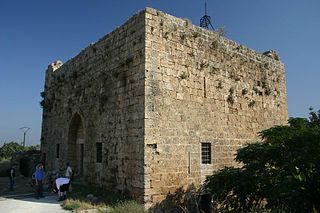 W
WChastel Rouge, also called Qal’at Yahmur is a small Crusader stronghold in the North West of Syria that belonged to the County of Tripoli. It is also identified as Castrum Rubrum mentioned in Latin texts. The castle stands in the village of Yahmur, at 12 kilometres' distance from Tartus and 10 kilometres from Safita, where the Tortosa and Chastel Blanc Crusader castles can be found.
 W
WThe Citadel of Raymond de Saint-Gilles, also known as Mons Peregrinus, Qala'at Sanjil and Qala'at Tarablus in Arabic, is a citadel and fort on a hilltop in Tripoli, Lebanon. It takes its name from Raymond de Saint-Gilles, the Count of Toulouse and Crusader commander who was a key player in its enlargement. It is a common misconception that he was responsible for its construction when in 1103 he laid siege to the city.
 W
WEin Hemed is a national park and nature reserve in the hills seven kilometres west of modern West Jerusalem and some 12 kilometres west of the Old City. It is also known by the Latin name it received from the Crusaders, Aqua Bella, and as Khirbat Iqbalā in Arabic. The park is located on the path of an old Roman road, also used in later periods. The road connected the coastal plain with Jerusalem, passing through Bab al-Wad. A fortified Hospitaller building from the Crusader period, relatively well preserved, is arguably the main attraction beside the streams and lush vegetation.
 W
WEnfeh, or Enfe, Anfeh, Anfe, is a town in the Koura district of the North Governorate of Lebanon at Latitude 34°21'0"N and Longitude 35°44'0"E. Enfeh borders the towns of Chekka, Al-Qalamoun, Barghoun and Zakroun. It is located 65 kilometres (40 mi) north of Beirut and 15 kilometres (9.3 mi) south of Tripoli. Its total area is 4.93 square kilometres (1.90 sq mi), and its population is around 6,500.
 W
WHaifa is the third-largest city in Israel—after Jerusalem and Tel Aviv—with a population of 285,316 in 2019. The city of Haifa forms part of the Haifa metropolitan area, the third-most populous metropolitan area in Israel. It is home to the Baháʼí Faith's Baháʼí World Centre, and is a UNESCO World Heritage Site and a destination for Baháʼí pilgrimage.
 W
WHarem or Harim (Arabic: حَارِم, romanized: Ḥārim, also Ḥāram is a Syrian city within the Idlib Governorate. It has an altitude of 160 meters and a population of 21,934. Harem is situated on the border with Turkey, 55 km west of Aleppo.
 W
WKantara Castle is a castle in north Cyprus. The exact date of its construction remains unknown, the most plausible theory being the Byzantine period. It combines Byzantine and Frankish architectural elements, became derelict in 1525 and was dismantled in 1560. It gave its name to the nearby Kantara monastery.
 W
WKolossi Castle is a former Crusader stronghold on the south-west edge of Kolossi village 14 kilometres (9 mi) west of the city of Limassol on the island of Cyprus. It held great strategic importance in the Middle Ages, and contained large facilities for the production of sugar from the local sugarcane, one of Cyprus's main exports in the period. The original castle was possibly built in 1210 by the Frankish military, when the land of Kolossi was given by King Hugh I to the Knights of the Order of St John of Jerusalem (Hospitallers).
 W
WKrak des Chevaliers or Crac des Chevaliers, also called Ḥiṣn al-Akrād and formerly Crac de l'Ospital, is a Crusader castle in Syria and one of the most important preserved medieval castles in the world. The site was first inhabited in the 11th century by Kurdish troops garrisoned there by the Mirdasids. In 1142 it was given by Raymond II, Count of Tripoli, to the order of the Knights Hospitaller. It remained in their possession until it fell in 1271.
 W
WLe Destroit is a ruined medieval fortress, built by the Crusaders in the early 12th century CE, located near the town of Atlit, Israel.
 W
WThe medieval Limassol Castle is situated near the old harbour in the heart of the historical centre of the city of Limassol. The castle as it appears today is a structure rebuilt circa 1590 under the period of Ottoman rule.
 W
WMajdal Yaba was a Palestinian Arab village in the Ramle Subdistrict, located 18.5 kilometres (11.5 mi) northeast of Ramla and 4 kilometres (2.5 mi) east of Jaffa. A walled city stood at the same site as early as 3000 BCE, and Majdal Yaba is first mentioned by the name Aphek in Egyptian Execration texts dating to the 19th century BCE. In the Bible's Old Testament, Aphek is described as a city conquered from the Canaanites by the Israelites, who then lost it to the Philistines. It is also mentioned in extrabiblical Babylonian and Assyrian texts as a Philistine stronghold. Under Roman rule, the city was known as Antipatris and the Crusaders, who built a fort there, renamed it Mirabel. During the Islamic period it became known as Majdal Yaba. For a short time under Ottoman rule, its name was changed from Majdal Yaba to Majdal Sadiq and then back again.
 W
WMaraclea was a small coastal Crusader town and a castle in the Levant, between Tortosa and Baniyas (Buluniyas). The modern-day location is known as Maraqîya which had a population of 1,254 in the 2004 census, according to the Syria Central Bureau of Statistics (CBS).
 W
WMargaliot is a moshav in northern Israel. Located along the border with Lebanon in the Upper Galilee, near the town of Kiryat Shmona, it falls under the jurisdiction of Mevo'ot HaHermon Regional Council. In 2019 it had a population of 412, most of them Jews of Iranian Kurdish descent.
 W
WMargat, also known as Marqab, is a castle near Baniyas, Syria, which was a Crusader fortress and one of the major strongholds of the Knights Hospitaller. It is located around 2 kilometres (1.2 mi) from the Mediterranean coast and approximately 6 kilometres (3.7 mi) south of Baniyas. The castle remained in a poor state of preservation until 2007 when some reconstruction and renovation began.
 W
WMigdal Afek, also Migdal Tsedek, is a national park on the southeastern edge of Rosh HaAyin, Israel.
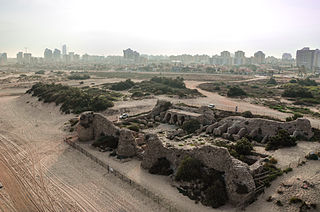 W
WMinat al-Qal'a, sometimes wrongly named Qal'at al-Mina, is a medieval coastal fort protecting the port known as Ashdod-Yam, which was historically separate from Ashdod proper but whose archaeological remains are today located on the southern beach of the sprawling modern city of Ashdod. The fort has been built by the Umayyads and later restored and used again by the Crusaders.
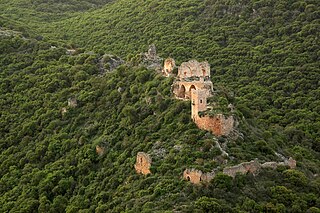 W
WMontfort is a ruined Crusader castle in the Upper Galilee region in northern Israel, about 22 miles (35 km) northeast of the city of Haifa and 10 miles (16 km) south of the border with Lebanon.
 W
WMontreal, or Qal'at ash-Shawbak in Arabic, is a castle built by the Crusaders and expanded by the Mamluks, on the eastern side of the Arabah Valley, perched on the side of a rocky, conical mountain, looking out over fruit orchards below. The ruins are located next to the modern town of Shoubak in Jordan.
 W
WMotza, also Mozah or Motsa, is a neighbourhood on the western edge of West Jerusalem. It is located in the Judean Hills, 600 metres above sea level, connected to Jerusalem by the Jerusalem–Tel Aviv highway and the winding mountain road to Har Nof. Established in 1854, Motza was the first Jewish farm founded outside the walls of the Old City in the modern era. It is believed to be located on the site of a Biblical village of the same name mentioned in Joshua 18:26.
 W
WThe Mseilha Fort is a fortification situated north of the Village of Hamat in Lebanon. The current fort was built by Emir Fakhreddine II in the 17th century to guard the route from Tripoli to Beirut. The fort is built on a long, narrow limestone rock near the Nahr el-Jawz River. Its walls are constructed with small sandstone blocks quarried from the nearby coast and built onto the edge of the limestone rock. The thickness of the walls ranges from 1.5 to 2 meters. The larger limestone blocks are the only remains of an earlier structure probably built for the same defensive reason.
 W
WQaqun was a Palestinian Arab village located 6 kilometers (3.7 mi) northwest of the city of Tulkarm at the only entrance to Mount Nablus from the coastal Sharon plain.
 W
WSafed is a city in the Northern District of Israel. Located at an elevation of 900 metres (2,953 ft), Safed is the highest city in the Galilee and in Israel.
 W
WSahyun Castle, also known as the Castle of Saladin, is a medieval castle in northwestern Syria. It is located 7 km east of Al-Haffah town and 30 km east of the city of Latakia, in high mountainous terrain on a ridge between two deep ravines and surrounded by forest, the site has been fortified since at least the mid 10th century. In 975 the Byzantine Emperor John I Tzimiskes captured the site and it remained under Byzantine control until around 1108. Early in the 12th century the Franks assumed control of the site and it was part of the newly formed Crusader state of the Principality of Antioch. The Crusaders undertook an extensive building programme, giving the castle much of its current appearance. In 1188 it fell to the forces of Saladin after a three-day siege. The castle was again besieged in 1287, this time both defender and belligerent were Mamluks. In 2006, the castles of Qal'at Salah El-Din and Krak des Chevaliers were recognised as a World Heritage Site by UNESCO. The site is owned by the Syrian government.
 W
WThe Saint Hilarion Castle lies on the Kyrenia mountain range, in Cyprus. This location provided the castle with command of the pass road from Kyrenia to Nicosia. It is the best preserved ruin of the three former strongholds in the Kyrenia mountains, the other two being Kantara and Buffavento.
 W
WThe Castle of Saint Louis, also known as Qalaat al Muizz or the Land Castle, is a ruined castle in Sidon, Lebanon. It was built in 1254 by French crusaders on the site of an earlier Fatimid fortress, and was altered a number of times until the 17th century.
 W
WSarvandikar, also spelled Sarvanda k'ar. It was the Frankish castle of Savranda and is officially known today as Savranda Kalesi. The site is a medieval castle in the former Armenian Kingdom of Cilicia, located in Turkey's Osmaniye Province approximately 115 kilometers east of Adana.
 W
WSepphoris or Zippori in the past called Diocaesaraea and, during the Crusades, le Saforie, is a former village and an archaeological site located in the central Galilee region of Israel, 6 kilometers north-northwest of Nazareth. It lies 286 meters above sea level and overlooks the Beit Netofa Valley. The site holds a rich and diverse historical and architectural legacy that includes Hellenistic, ancient Jewish, Roman, Byzantine, Islamic, Crusader, Arab and Ottoman remains. In Mandatory Palestine it was a town known as Saffuriya, with a population of approximately 5,000 people, until its depopulation in 1948.
 W
WThe Siege of Jacob's Ford was a victory of the Muslim sultan Saladin over the Christian King of Jerusalem, Baldwin IV. It occurred in August 1179, when Saladin conquered and destroyed a new border castle built by the Knights Templar at Jacob's Ford on the upper Jordan River, a historic passage point between the Golan Heights and northern Galilee. Jacob's Ford is also known by the Latin name of Vadum Iacob and in modern Hebrew as Ateret. Many scholars believe that Saladin's reconquest of the Holy Land and Jerusalem in 1187 was heralded by this earlier victory.
 W
WTiberias is an Israeli city on the western shore of the Sea of Galilee. Established around 20 CE, it was named in honour of the second emperor of the Roman Empire, Tiberius. In 2019 it had a population of 44,779.
 W
WThe Tomb of Samuel, commonly known as Nebi Samuel or Nebi Samwil, is the traditional burial site of the biblical Hebrew and Islamic prophet Samuel, atop a steep hill at an elevation of 908 meters above sea level.
 W
WThe Tower of David, also known as the Citadel, is an ancient citadel located near the Jaffa Gate entrance to the Old City of Jerusalem.
 W
WTrapessac is a medieval fortress located 4 km north of the town of Kırıkhan in Hatay Province, Turkey. Trapessac was constructed in the 12th century by the Knights Templar and, together with the nearby fortress at Bagras, guarded the Syrian Gates, the principal pass between the coastal region of Cilicia and inland Syria.
 W
WTzova, also Palmach Tzova or Tzuba is a kibbutz in central Israel. Located in the Judean Hills, on the western outskirts of Jerusalem, it falls under the jurisdiction of Mateh Yehuda Regional Council. In 2019 it had a population of 625.
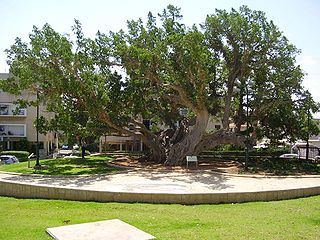 W
WUmm Khalid, also called Mukhalid, was a Palestinian village in the Tulkarm Subdistrict, 15 kilometers (9.3 mi) west of Tulkarm. It was an ancient site in the central coastline of what is now the city of Netanya, Israel.
 W
WYaka Castle is a castle ruin in Mersin Province, Turkey. Although its name is Güdübeş, it is popularly known as Yaka referring to a former village to the east of the castle.
 W
WYılankale is a late 12th–13th century Armenian castle in Adana Province of Turkey. It is known in Armenian as Levonkla after its possible founder—King Leo (Levon) I the Magnificent of the Armenian Kingdom of Cilicia. Medieval Armenian names attached to the site are Kovara and Vaner.